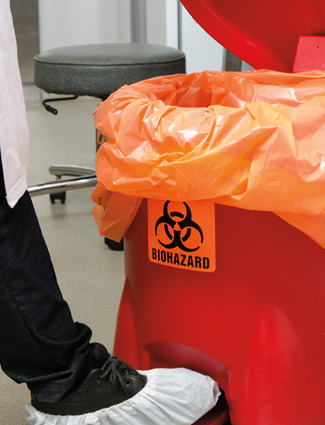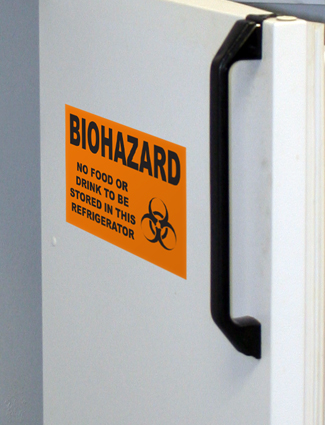How Warning Labels Help Manage Biohazardous Waste

There are an estimated 16 billion injections administered globally each year, and not all of the used syringes and needles end up properly disposed of, creating risks of injury and infection as well as opportunities for reuse, according to the World Health Organization (WHO).
A person who experiences a needle stick injury from a needle used on an infected patient has a 30% risk of becoming infected with Hepatitis B, 1.8% risk of Hepatitis C, and 0.3% risk of HIV. You can avoid costly citations and prevent harmful exposure by practicing proper use of waste containers and biohazard safety labeling.
The OSHA Standard for Waste Segregation
 Incorrect waste segregation and labeling are among the most common violations for healthcare facilities. Medical waste introduces an added risk of exposing medical personnel, waste handlers, and patients to harmful infections if it's not managed properly. No matter the type of biohazardous waste, it all has the possibility of being infectious. This is why biohazardous waste can never be put in a regular trash can.
Incorrect waste segregation and labeling are among the most common violations for healthcare facilities. Medical waste introduces an added risk of exposing medical personnel, waste handlers, and patients to harmful infections if it's not managed properly. No matter the type of biohazardous waste, it all has the possibility of being infectious. This is why biohazardous waste can never be put in a regular trash can.
The Occupational Safety and Health Administration's (OSHA) Bloodborne Pathogens Standard outlines requirements for employers. These requirements are designed to protect workers who may come into contact with blood or other potentially infectious materials (OPIM). Part of this standard includes consistent OSHA labeling and containment of biohazards using bags and containers. It also requires safety labels and signs to reduce the chances of harmful exposure from the facility to the outside world.
OSHA Container Requirements
Biohazard waste is anything that is soaked in blood. A good rule of thumb to follow to determine the type of container to use is to consider the level of risk the waste could have on a person's well-being. Essentially, the higher the risk the waste poses to humans, the more rigid the container you need. OSHA has rules for containers that carry regulated waste:
- Container must be closable.
- Constructed to prevent leakage and large enough to contain all the contents.
- Labeled and color-coded according to standards.
- Closed before removal to prevent spills during handling, transporting, shipping, or storage.
- If there is outside contamination of the waste container, it must be put into a second container.
Learn the purpose of each biohazard waste container and which method is best to use depending on the nature of the waste.
 Biohazard Labels and Signs
Biohazard Labels and Signs
Employers are responsible for clearly communicating biological hazards to employees through warning labels and signs. Biohazard warning labels must be fluorescent orange or red-orange and clearly display the word "biohazard" and the universal biohazard symbol in a contrasting color (usually black). Apply these safety labels as close as possible to the container with an adhesive, wire, string, or other method. Apply biohazard safety labels to:
- All bags/containers of waste used to store, transport, or dispose of blood and other potentially infectious material.
- Refrigerators and freezers that store blood or other potentially infectious material.
- Pathological waste containers.
- Entrance doors to work areas to warn and inform personnel of the presence of biohazards.
- Any equipment that has come into contamination with blood or other potentially infectious material. Make sure all durable labels includes information that states which portions of the equipment remains contaminated.
Red Medical Waste Bags and Containers
Use red bags to dispose of liquid and solid items contaminated with blood or other potentially infectious materials. If the waste can pour, drip, or flake off after drying, store it in a red bag or red color-coded container at the location it was used. OSHA also allows red bags or containers to be substituted for warning labels.
Sharps: All sharps such as used needles and anything used for cutting and injecting must be stored in a rigid, leak-proof, tamper-proof, and puncture-proof container. It can be made from a variety of products from cardboard to plastic. Label or color-code the container according to the bloodborne pathogens standard. If leakage is possible, place in a second container that is closable and prevents leakage during handling, storing, transport, or shipping. Upon closure, you can use duct tape to better secure the lid as long as it doesn't serve as the primary lid.
Individual Containers of Blood: Place in a labeled container during storage, transport, shipment, or disposal. If leaks are possible, place materials in a secondary container.
Contaminated Laundry: Put all laundry that's been in contact with blood or may contain sharps in a red bag. Items include gauze, gloves, gowns, bedding, bench paper, personal protective equipment (PPE), and more. If laundry is wet and at risk of leaking or soaking through from the bag or container, place laundry in bags or containers that prevent leakage.
Pathological Waste: Place any recognizable human or animal organs, body parts, and tissues in a red pathological waste container. This consists of a red rigid container with a tight lid with a red bag liner labeled with the universal biohazard symbol.
Tips for Maintaining OSHA Compliance
Here are five ways you can maintain workplace safety and OSHA compliance with managing biohazards in any facility:
Provide Consistent Training: Teach and train all employees on proper biohazard management to ensure consistency throughout your facility and reduce the chances of human error and harmful exposure. OSHA requires training at least annually following initial training.
Maintain Your Sharps Injury Log: Establish and maintain a sharps injury log for recording injuries due to contaminated sharps. This will allow you to recognize patterns and areas for improvement.
Be Mindful of Storage Areas: Different types of waste can be stored in the same room. Prevent mishandling and injuries by ensuring workers and custodial personnel are aware of the presence of biohazards and how to approach them safely. Clearly label and segregate waste to prevent human error and to maintain efficiency.
Reassess Hazards: Assess the work environment for any hidden hazards or improper work practices and take necessary steps to correct them. Safeguard your facility from newfound hazards by conducting refresher training for employees and adding emphasis to problem areas using safety labels and signs.
Asses Your Safety Labels and Signs: Do a walkthrough to determine if any safety labels or signs need updating, replacing, or other maintenance.
DuraLabel Warning Signs and Solutions for Biohazard Safety
All hazardous waste should be marked. Biohazard and bloodborne pathogen premade labels and signs are a convenient way to convey safety procedures, warnings, and communicate instructions to personnel anywhere. Apply safety labels to ensure everyone in your facility can tell what the waste is, how to handle it, and what to do in case of an accident.
You can also print biohazard custom safety labels on-demand using reliable supply that is engineered to remain legible and endure the environment using DuraLabel printers and supplies from DuraLabel. Meet OSHA bloodborne pathogens standards with compliant biohazard labels and waste management practices to enhance workplace safety and reduce the risk of contamination. Learn how OSHA's rules for bloodborne pathogens apply to biohazard labeling and get started. Download our free OSHA Signage Quick Start Guide to learn more about OSHA waring labels and signage.
Read Next:
DIY Labels or Premium Vinyl? Choosing the Right Safety Signs
Related Resources

CO2 Cylinder Tanks and the Art of Labeling
Dealing with dangerous substances is a major concern for any workplace. Whether it's chemicals that can burn ...
Read
Red Diamonds on HazCom 2012 Labels
Six elements of information must be present on the typical HazCom 2012 chemical label, as listed in OSHA's ...
Read
GHS and HazCom Labeling for Medical Facilities
Maintaining safe medical facilities starts with effective hazard communication (HazCom). The Globally ...
Read.png)





